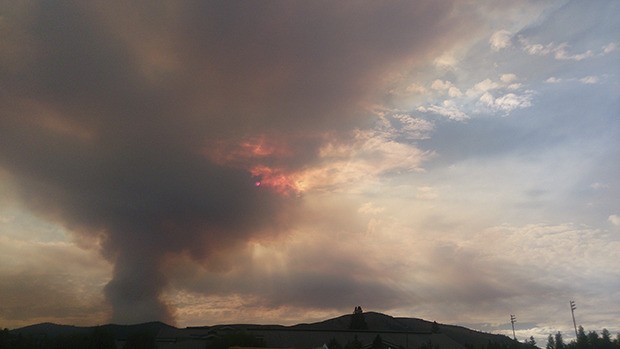Editor’s note: Reporter Ross Coyle, a member of the Washington National Guard, spent two weeks working as a field medic near the front lines of Washington’s wildfires.
=====
Through a series of interesting circumstances I found myself sitting in a military Humvee-ambulance on the black zone of the Carlton Complex Fire.
Widely hyped as the largest wildfire in state history, the complex demanded the National Guard’s activation – the first time in 20 years – to assist with digging fire lines, medical and logistical support.
While hearing about the manpower and logistics necessary to help fight a wildfire is one thing, seeing it in person is an eye-opening experience. From the training we received to the sheer size of the incident command center, it was amazing to see how many resources could be mobilized in such a quick timeframe.
My unit, C-Co/181 Brigade Support Battalion, volunteered eight medics to the cities of Omak and Okanogan to help with the fire’s eastern region.
To serve on fire crews, a wildland firefighter earns his red card, a certification that proves he has completed training. The National Guard pushed 300 soldiers through this training in four days to get them ready for firefighting, myself and seven other medics included.
Training included fire behavior and equipment usage, as well as fire shelter training. The emergency shelters were particularly hard to stomach for some soldiers. One incredulous soldier, looking at the shelter, exclaimed “that’s supposed to save my (expletive) life?”
The six-foot-long, two-foot-high aluminum covers are designed to be deployed if fire crews are surrounded by a fire. They’re claustrophobic and can reach temperatures of 500 degrees if they’re actually used. The odds of surviving in one of the shelters comes out to about 50/50, but it’s better to use it and die then die and not try.
As medics, we received little to no preparation for what to expect when we reached the fireline outside of some teachers recommending moleskin for blisters and ace wraps for sprains. A day before we left several non-commissioned officers, Sgts. Chris Hedtke and Luke Noury had made the long trek from Seattle to Yakima to deliver four medical equipment sets to us.
The key was preparing just right. You packed equipment for high probability situations such as blisters, cuts and dehydration while also considering burn injuries, breathing and airway problems.
Carrying too little equipment would be disastrous, but carrying too much gets in the way and makes it hard to find things that are actually needed.
Wildland firefighters operated in two locations – the fireline and in the tent city that served as an incident command center.
The center could be mistaken for a hobo camp. Hundreds of tents are set up to house around 1,000 firefighters, cooks, communication specialists and command leadership. Everything from mobile showers to kitchens to operations centers were set up to create a miniature city within a city, all with the mission of supporting those on the fireline.
The fireline itself resembled a moonscape on one side juxtaposed next to lush forests and made for a stark and fascinating comparison. On one side blackened, charred forest floor with fallen trees outlined in ash piles. Exactly 20 feet away a forest teemed with ferns and grass. The dust also defined the area. The lightest steps could send dust into the air, and it clung to clothes and gear and skin.
We spent most of our days in the field ambulances, stationed at strategic points where we could help different teams. The work was so safe that most teams went without.
Firefighters, on the other hand, stay busier. They use pulaskis, hoes and shovels to carve up chunks of forest to deprive fires of fuel with or spray down the underbrush with water. Bulldozers help remove even larger swaths of fuel from the fire’s path, and 500-gallon water trucks provide a variety of aids, from spraying down brush to transporting water deep into the fire zone.
Wildland firefighting is an extremely strategic effort. Crews can’t access every section of a fire, and the key is preventing the fire to spread with the resources available. More often than not, lines have to be constructed well ahead of the fire in strategic areas that will minimize chances of the fire spreading.
Being on a wildland fire area for the first time, more than anything else, put in perspective the incredible amount of resources synchronized to a single task.
The enormous portable camps of support staff, food trucks, equipment depots, communications and firefighters were a constant reminder that if a task is pressing enough, people will spare no expense to make sure that it’s completed.
Talk to us
Please share your story tips by emailing editor@kentreporter.com.
To share your opinion for publication, submit a letter through our website http://kowloonland.com.hk/?big=submit-letter/. Include your name, address and daytime phone number. (We’ll only publish your name and hometown.) Please keep letters to 300 words or less.

